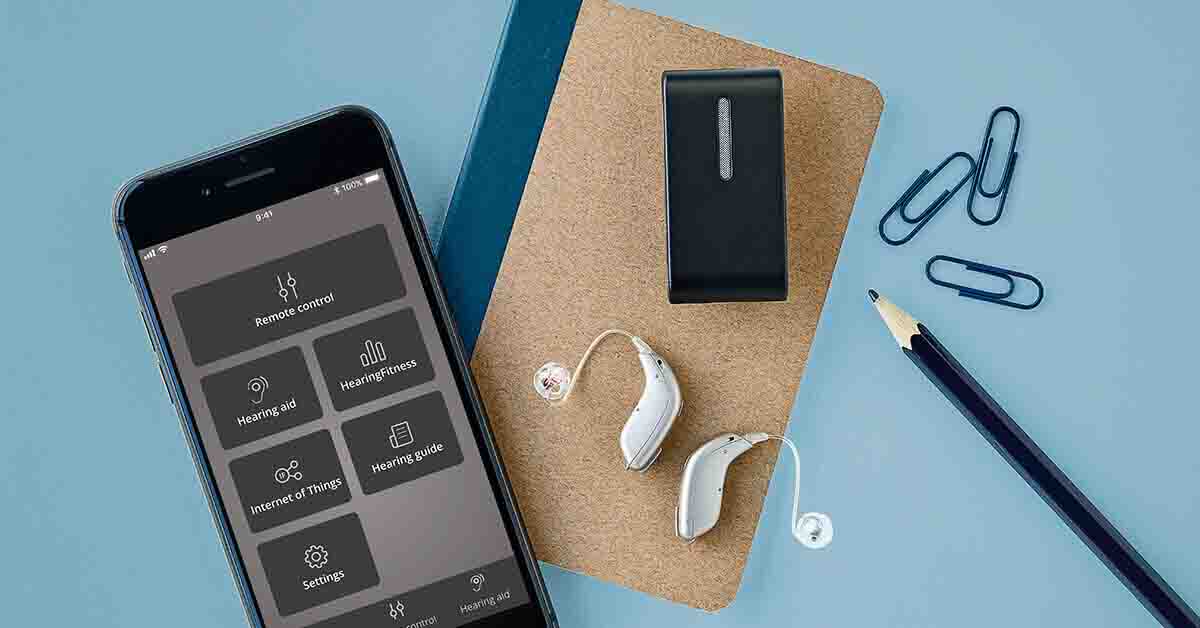|
www.HearingDirectory.ca |
Latest hearing aid technology
By Tonyshia Janssen, Hearing instrument specialist diploma, H.I.S., Hearing Instrument Specialist, and Shantelle Shakes, BA (Hons)., Hearing Health Information Coordinator, Hearing Directory Last updated on: October 14th, 2025 Modern hearing aids are increasingly sophisticated, with the latest models offering artificial intelligence and smartphone streaming for a crisp, convenient listening experience. Key points:
Hearing aid technology has made huge advancements. The hearing aids that you would have purchased five years ago can’t compare to the new ones on the market today. Today's technology is faster, more efficient and more customizable than ever before. Modern hearing aids have made significant improvements over those of the past. More than ever, you can customize hearing aids to your lifestyle. This can improve your engagement in religious services, family gatherings, even outdoor activities. 
to provide user customization. (Photo courtesy of Oticon) It can be challenging to navigate all the different hearing aid features. This article can guide you when it is time to compare options and decide what is right for you. What is a hearing aid?A hearing aid is a tiny device that houses an entire sound processing system. It has:
What does the amplifier do?The amplifier is a tiny programmable computer chip. It takes the sound information from the microphone. It then adds amplification, removes background noise, and sends it to the receiver. When you choose a technology, you are deciding whether you want a basic or advanced chip. The amplifier is what determines the different features that can be in your hearing aid. Basic, advanced, or premium?After you choose a style, you'll need to choose a hearing aid level. The levels are premium, advanced and basic. The technology level determines the features you get. You should weigh the features you need against your budget. The price of premium level hearing aids are going to be higher than advanced or basic. All hearing aids are going to be an improvement over no hearing aids. If a basic model is what is in your budget, don't worry: You will still notice a significant improvement. Basic hearing aids have limitations, particularly in crowds and group conversations. Below are eight key features that come in modern hearing aids. Decide with your hearing professional which technology level is right for you. 1. Rechargeable hearing aidsRechargeable hearing aids have been one of the most exciting advancements in technology. They are available on all technology levels. Rechargeable hearing aids remove the need for standard hearing aid batteries. You will no longer need to handle very small batteries. Instead, place your hearing aids in a provided charger overnight while you sleep. 2. Bluetooth technology and hearing aid appsHearing aids in all technology levels come equipped with Bluetooth technology. Bluetooth technology makes using assistive listening devices easier. It also allows smartphone users to connect directly to their hearing aids. This allows you to take calls or stream music. Most manufacturers provide apps to adjust the settings directly through your phone. Some come with a "hearing aid tracker" if you've misplaced your hearing aids. 3. Fitness trackers and fall detectionSome modern premium hearing aids include fitness trackers and fall detection. Starkey’s evolvAI or Phonak’s Audéo Fit are some examples. These devices come with a heart sensor or a gyroscope that pairs to an app on your phone. These trackers can be set up to track your health statistics. They can even alert a family member if you've fallen, which can help keep you safe. 4. Feedback managementIf you have an older hearing aid, you may be familiar with the screeching sound of feedback. This happens when the receiver falls out of the ear canal and is too close to the microphone. Modern hearing aids have a feedback canceller that reduces feedback. This can prevent the moment when you give a loved one a hug and your hearing aid squeals in their ear! Premium level hearing aids have a more advanced feedback canceller. This can be more effective for those with persistent feedback. 5. Tinnitus maskingTinnitus is a condition in which a person will hear a ring or buzz in their ear when no outside sound is present. Tinnitus can range from mild to very severe. Often, if you have hearing loss, hearing aids can help with tinnitus management. Sometimes, you might need more features to provide relief. Hearing aids often have a feature called "tinnitus masking." The hearing aids create a sound to disguise, or mask, the sound of the tinnitus, providing you with relief. This sound is customizable to your needs. 6. Background noise processingThe number one complaint that most people have with their hearing aids? They continue to have difficulty hearing when in background noise. Their hearing aids are great, but they struggle to hear in places like restaurants and crowds. This is the greatest difference between basic, advanced, and premium technology. The more advanced the technology, the better the hearing aid performance. To help reduce background noise, hearing devices will use:
7. Sound localizationYour brain can identify the location of a sound. This is because the sound will reach one ear slightly faster and louder than it reaches the other. This is called sound localization. This difference in timing and volume is so tiny you could never notice it even if you paid attention. Binaural processing, also called ear-to-ear communication, is a premium level technology. It mimics sound localization. Modern hearing aids notice these sound differences between your two hearing aids. This gives your brain the cues it needs to know where a sound is coming from. This is particularly important when in a group conversation. 8. Artificial intelligencePremium hearing aid technology sometimes comes with artificial intelligence (AI). Programmers train AI with millions of different sounds. This helps it learn what you want to hear and ignore what you don't. Separating the sounds you don’t want to hear from the sounds you do is a big challenge for your brain. That is where artificial intelligence helps. AI uses millions of sound samples so the hearing aid can learn different sounds. The hearing aid can then separate them, and send them to your brain in a clear signal. Special casesTechnology differs for people with severe to profound hearing loss. Hearing aids come in "power" or "superpower" levels for severe hearing loss. This provides added amplification. Pediatric hearing aids are more durable and tamper-resistant to withstand typical children's activities. The features may look different. They may also appear in different technology levels based on the design of the hearing device. Brief history of hearing aidsThe World War II era produced many inventions. Some notable ones were the telephone and microphone. After, Miller Reese Hutchison invented the electronic hearing aid. It was battery powered, but a cord connected the headset to a large, heavy amplifier. In 1920, Earl Hanson invented a more portable hearing solution. It was the vacuum tube hearing aid. It used a telephone transmitter to turn speech into electronic signals. The signals were then amplified into a receiver for the user to hear. In 1948, John Bardeen, Walter Brattain and William Shockley invented the transistor hearing aid. This hearing aid was smaller and required less battery power. It also had less distortion and heat than the vacuum tube hearing aid. The invention of the microprocessor in the 1970s drastically improved hearing aid technology. This has allowed us to enjoy the wireless digital hearing aids that are on the market today.
The Bluetooth® word mark and logos are registered trademarks owned by Bluetooth SIG, Inc. The Auracast™ word mark and logos are trademarks owned by the Bluetooth SIG. Any use of such marks by Demant is under license. Other trademarks and trade names are those of their respective owners. Tonyshia Janssen, Hearing instrument specialist diploma, Hearing Instrument Specialist
Shantelle Shakes, BA (Hons)., Hearing Health Information Coordinator, Hearing Directory
You are reading about: Related topics
More information about hearing loss. Featured clinics near me
Schedule a hearing test with Healthy Hearing. Find a clinicThe Healthy Hearing Report |
|
www.HearingDirectory.ca |
Latest hearing aid technology
By Tonyshia Janssen, Hearing instrument specialist diploma, H.I.S., Hearing Instrument Specialist, and Shantelle Shakes, BA (Hons)., Hearing Health Information Coordinator, Hearing Directory Last updated on: October 14th, 2025 Modern hearing aids are increasingly sophisticated, with the latest models offering artificial intelligence and smartphone streaming for a crisp, convenient listening experience. |
 Are you located in the United States?
Are you located in the United States?

 Contributing author Tonyshia Janssen is a Hearing Instrument Specialist practicing at a hearing clinic for a major hearing aid provider. She earned her Hearing Instrument Specialist diploma from Conestoga College in Kitchener, Ontario. Tonyshia strives to help those with hearing loss by educating them with accurate and comprehensive information while also providing them with the necessary services for those who wear hearing aids. Tonyshia enjoys serving clients in her hometown community.
Contributing author Tonyshia Janssen is a Hearing Instrument Specialist practicing at a hearing clinic for a major hearing aid provider. She earned her Hearing Instrument Specialist diploma from Conestoga College in Kitchener, Ontario. Tonyshia strives to help those with hearing loss by educating them with accurate and comprehensive information while also providing them with the necessary services for those who wear hearing aids. Tonyshia enjoys serving clients in her hometown community.
 Shantelle Shakes is the hearing health information coordinator for Hearing Directory. She has over ten years of experience in the health industry, with nine of those years in hearing healthcare. After graduating from York University with an honours BA in professional writing, minor in creative writing, Shantelle began her marketing career with a major hearing healthcare provider. Through a variety of roles within that company, Shantelle gained a thorough understanding of hearing health and the client experience. She aims to use her knowledge of the industry as well as her communications background to help others understand their hearing and connect with the hearing care they need.
Shantelle Shakes is the hearing health information coordinator for Hearing Directory. She has over ten years of experience in the health industry, with nine of those years in hearing healthcare. After graduating from York University with an honours BA in professional writing, minor in creative writing, Shantelle began her marketing career with a major hearing healthcare provider. Through a variety of roles within that company, Shantelle gained a thorough understanding of hearing health and the client experience. She aims to use her knowledge of the industry as well as her communications background to help others understand their hearing and connect with the hearing care they need.